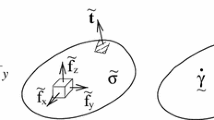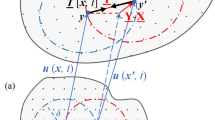Abstract
The tightening of industrial safety standards for structures generates a need for refined computational methods, which, among other things, must be able to describe the yield surface and the deformation behaviour of non-reinforced thermoplastics. To describe the plastic behaviour of materials, a potential formulation is suggested. This formulation contains a number of known potentials as special cases. The parameters of the model, which are obtained from test data, are restricted by the convexity condition for the potential. The new model allows one to take into account effects of the second order, for instance, the unequal behaviour under tension and compression, the plastic compressibility, and the Poynting-Swift effect. For each particular choice of the parameters, the Poisson ratio in tension is computed. If the restrictions imposed on the Poisson ratio do not hold, the application of a non-associated flow rule is necessary. A simple non-associated flow rule with different values of Poisson ratio intension and compression is proposed.
Similar content being viewed by others
References
H. Altenbach, J. Altenbach and A. Zolochevsky, Erweiterte Deformationsmodelle und Versagenskriterien der Werkstoffmechanik, Deutscher Verlag für Grundstoffindustrie, Stuttgart (1995).
G. Backhaus, Deformationsgesetze, Akademie Verlag, Berlin (1983).
M. Życzkowski, Combined Loadings in the Theory of Plasticity, PWN-Polish Scientific Publishers (1981).
R. Bardenheier, Mechanisches Versagen von Polymerwerkstoffen: Anstrengungsbewertung mehrachsialer Spannungszustände, Hanser Verlag, München (1982).
J. Betten, Creep Mechanics, Springer, Berlin (2005).
Yu. I. Yagn, “New methods of material strength computation,” Vestn. Inzh. Tekh., 6, 237–244 (1931).
V. A. Kolupaev, Dreidimensionales Kriechverhalten von Bauteilen aus unverstärkten Thermoplasten, Diss., Martin-Luther Universität Halle-Wittenberg, Papierflieger Verlag, Clausthal-Zellerfeld (2006).
M. Sayir, “Zur Fließbedingung der Plastizitätstheorie,” Ing. Arch., 39 414–432 (1970).
S. Voesik, Handbook on the Strength of Materials [in Russian], Budivelnik Kiev (1970).
V. A. Kolupaev, A. Kraatz, M. Moneke, and A. Bolchoun, “Beschreibung der mehraxialen Kriechphänomene bei Hartschaumstoffen,” Kautsch., Gummi, Kunststoffe, KGK 1-2, 17–27 (2006).
V. A. Kolupaev, M. Moneke, M. Rudschuck, and F. Becker, “Modellierung des mehraxialen Grenzverhaltens von Keramiken,” in: W. Krenkel, cfi Ceramic forum international, Sonderausgabe zum DKG-DGM Symposium Hochleistungskeramik und der DKG-Jahrestagung, 12–13 Oktober 2005, Göller Verlag, Baden-Baden (2005), pp. 150–153.
S. Kolling, A. Haufe, M. Feucht, and P. Du Bois, “SAMP-1: A semi-analytical model for the simulation of polymers,” in: 4. LS-DYNA Anwenderforum 20.–21. Oktober 2005, Bamberg (2005), pp. A-II-27–A-II-52.
S. Kolling and A. Haufe, “A constitutive model for thermoplastic materials subjected to high strain rates,” in: Proc. Appl. Math. Mech., 5, 303–304 (2005).
A. Föppl and L. Föppl, Drang und Zwang: Eine höhere Festigkeitslehre für Ingenieure, R. Oldenbourg Verlag, München, Berlin (1920), p. 50.
V. A. Kolupaev, M. Moneke, and F. Becker, Mehraxiales Kriechen von Thermoplast-Formteilen, VDI-Verlag, Düsseldorf (2005).
H. Altenbach, P. Schieße, and A. Zolochevsky, “Zum Kriechen isotroper Werkstoffe mit komplizierten Eigenschaften,” Rheol. Acta, 30, 388–399 (1991).
H. Altenbach, A. Bolchun, and V. A. Kolupaev, “Models for spatial mechanical behaviour of non-reinforced thermoplastics,” in: W. Grellmann, Hrsg., 11 Tagung Deformations und Bruchverhalten von kunststoffen, 20–22 Juni 2007, Martin-Luther-Univesität, Merseburg.
Author information
Authors and Affiliations
Additional information
Russian translation published in Mekhanika Kompozitnykh Materialov, Vol. 43, No. 3, pp. 367–384, May–June, 2007.
Rights and permissions
About this article
Cite this article
Kolupaev, V.A., Kolling, S., Bolchoun, A. et al. A limit surface formulation for plastically compressible polymers. Mech Compos Mater 43, 245–258 (2007). https://doi.org/10.1007/s11029-007-0024-0
Received:
Revised:
Issue Date:
DOI: https://doi.org/10.1007/s11029-007-0024-0




